Mary Hoffman's Blog, page 13
August 22, 2012
I'll tell you what's showing at the Roxy ...
 Photo: Fin Fahey.Writers are terrible people to watch films with. Or television dramas. They may even hiss messages to you in the theatre. In fact, if novel-reading were a more sociable activity than it usually is, they would be loud and annoying fellow-readers. The thing is they know how plots work and they see things coming.
Photo: Fin Fahey.Writers are terrible people to watch films with. Or television dramas. They may even hiss messages to you in the theatre. In fact, if novel-reading were a more sociable activity than it usually is, they would be loud and annoying fellow-readers. The thing is they know how plots work and they see things coming.I have recently been watching (or trying to watch) lots of DVDs with a friend, another writer, who is much more into films than I am. Some have been more successful than others as choices to satisfy both of us. And there are several reasons for not enjoying a film, not all of them to do with the quality of the film itself.
However, we have recently given up on three films and I am trying to understand why. The first was Jackie Brown, not in itself a bad one (and it had Oscar nominations). But as soon as I knew what Samuel L. Jackson had in mind for his first victim, I felt I knew more or less how the story was going to play out. (The plot summary on Wikipedia has confirmed this more or less).
The second to fall prey to the Eject button was Water for Elephants and we gave it two chances over two nights. It didn't help that Robert Pattison should really not play roles where he is required a/ to smile or b/ to show any emotions beyond "moody vampire." Or that animal cruelty was involved. But I found myself predicting that he would heal the dwarf's antagonistic dog of an illness, that the elephant would kill the cruel ringmaster etc etc. (as well as the obvious R-Patz falling for Reece Witherspoon who is married to cruel ringmaster - anyone could have seen that coming).
"Right," said my friend. "We'll watch John Carter. It's got Taylor Kitsch in it."

I've got no objection to watching less-than-marvellous films with handsome young men in them but really we could not abide it and back in its Love Film envelope it went.
What was the problem? The film-maker had completely forgotten the art of storytelling and the arc of story. It had FOUR beginnings, to start with - a framing device that went out with Heart of Midlothian and Wuthering Heights. Once into the story proper (based on the first of a series of eleven books by Edgar Rice Burroughs), we were on Mars.
Cue tall aliens with four arms and our hero bouncing ridiculously high with each step because his bones are too light for the atmosphere or some such taradiddle. Add a pleasingly martial beautiful princess in regulation Leia-type gold bra and harem pants, a lovable monster, some spooky villains and elaborate space craft and you have the full panoply of SF tropes and clichés to play with.
But oh the names! I invented the term Erg of Slerg for that brand of fantasy or SF which majors on long, awkward or plain unpronounceable names and they were here in spades. Dejah Thoris is the princess (who might just as well have been called Deja Vu) and there was Tars Tarkas, Sab Tharn, Tal Hajus, Tardos Mors ... are you chewing your own arm off yet?
Where was Jabba the Hutt when you needed him? Or Obi-wan Kenobi and Luke Skywalker? At least George Lucas could do names. And he knew that you mustn't linger over a spacecraft in proportion to the money it cost to build it. He also knew - at least when he made the first Star Wars movies in the 1970s that what really mattered was story (he seems to have forgotten all that in the second trilogy).
"Doesn't Taylor Kitsch have a beautiful mouth?" said my friend hopefully. But no-one could really have made anything remotely fascinating out of this pig's ear of a plot and script.
It had Dominic West too. And Ciaran Hinds. And Mark Strong. I even glimpsed Art Malik. And lots of CGI. But someone had forgotten TO TELL THE STORY! No amount of fireworks and 3D and hot blokes with their shirts off and special effects can make up for it if that one basic essential is overlooked.
Someone please tell me a good recent film we can watch on DVD next time. Somebody tell me something good that's showing at the Roxy. I won't even moan if I can guess what's coming. That's a given.
Published on August 22, 2012 13:23
August 15, 2012
Verbatim
On Saturday I saw a play at the National Theatre, unlike anything I have seen staged before. It was London Road, a piece of "verbatim theatre" by Alecky Blythe, with music by Adam Cork. Our visit was organised by our theatre producer daughter, who had seen London Road at the Cottesloe last year and was keen to let everyone know about its revival at the Olivier.
But a musical based on the murders of five prostitutes in Ipswich a few years ago would not have been something I was naturally attracted to. And how wrong I would have been to let the subject matter put me off.
For a start, it's not "about" the murders that Steve Wright was convicted of committing. It's about the reactions of local Ipswich inhabitants to those murders or rather to everything that came in the wake of those murders: invasions by news teams and tabloid journalists, police tape cordons, suspicions of every man in the street.
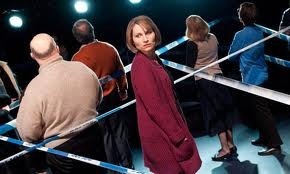 So the London Road Neighbourhood Watch is formed to re-establish some kind of normality, which they do through Quiz nights and a London Road in Bloom competition, won every year by the same person. The play begins with their AGM and immediately we are in a world familiar to anyone who has ever organised a protest, tried to save a library or whatever.
So the London Road Neighbourhood Watch is formed to re-establish some kind of normality, which they do through Quiz nights and a London Road in Bloom competition, won every year by the same person. The play begins with their AGM and immediately we are in a world familiar to anyone who has ever organised a protest, tried to save a library or whatever.
So although most members of the audience would have been untouched by murder, there is something much more common to relate to. The words spoken by the very versatile group of eleven actors are all taken from interviews taped by the writer (that's where the "verbatim" comes from.) And the music - with strong touches of John Adams - takes its shape from the words, leading to fugues, ensembles and haunting motifs.
Kate Fleetwood, who was Lady to Patrick Stewart's Macbeth recently, is now Julie, the dowdy committee secretary, in a long cardigan, organising the multiple flower baskets that have burgeoned to sweeten the atmosphere of the road. "Petunias, begonias and ....impatience [sic]" she sings.

Rather touchingly, the residents of London Road don't know much about flowers, referring to "lily-type things" and Busy Lizzies as if they were different from Impatiens. And the monstrous prize-winning garden wheeled on at the end has grottoes, gnomes, a lighthouse, Jesus and the Virgin Mary!
We are a long way from naked strangled prostitutes by this point. But the neighbours have been haunted by the idea that the women could have been killed in Steve Wright's house - in "their" road. "He only lived here ten weeks - ten weeks!" Strangely this urgent question is never answered.
There was a period when their lives were all questions, every male a potential murderer. "You automatically think it could be him," is one particularly memorable refrain. This is suburbia trying hard to unthink the unthinkable, while speaking of the unspeakable.
'Any man has to, needs to, wants to/ Once in a lifetime, do a girl in," says Sweeney in T S Eliot's fragment Sweeney Agonistes, and you feel that demotic ghost hovering over the production.
I found it arresting, moving and fascinating but wouldn't have wanted it to go on a moment longer than its two hours, ten minutes (including interval). As with reading the virtuoso novels of Roddy Doyle, I felt claustrophobically hemmed in by the predictable cliché-ridden language and thought patterns. No-one had an original idea or word.
In the most emotive scene, three surviving prostitutes sing about how they don't work the streets round London Road any more. But that is shutting the stable door after the horse has bolted, as I'm surprised someone didn't say.
And one resident really must have said to Alecky Blythe that they would shake the hand of the man that did it, because it had cleaned the girls off London Road.
Behind the lace curtains and the petunias some have hearts of gold, others of stone.
But a musical based on the murders of five prostitutes in Ipswich a few years ago would not have been something I was naturally attracted to. And how wrong I would have been to let the subject matter put me off.
For a start, it's not "about" the murders that Steve Wright was convicted of committing. It's about the reactions of local Ipswich inhabitants to those murders or rather to everything that came in the wake of those murders: invasions by news teams and tabloid journalists, police tape cordons, suspicions of every man in the street.
 So the London Road Neighbourhood Watch is formed to re-establish some kind of normality, which they do through Quiz nights and a London Road in Bloom competition, won every year by the same person. The play begins with their AGM and immediately we are in a world familiar to anyone who has ever organised a protest, tried to save a library or whatever.
So the London Road Neighbourhood Watch is formed to re-establish some kind of normality, which they do through Quiz nights and a London Road in Bloom competition, won every year by the same person. The play begins with their AGM and immediately we are in a world familiar to anyone who has ever organised a protest, tried to save a library or whatever.So although most members of the audience would have been untouched by murder, there is something much more common to relate to. The words spoken by the very versatile group of eleven actors are all taken from interviews taped by the writer (that's where the "verbatim" comes from.) And the music - with strong touches of John Adams - takes its shape from the words, leading to fugues, ensembles and haunting motifs.
Kate Fleetwood, who was Lady to Patrick Stewart's Macbeth recently, is now Julie, the dowdy committee secretary, in a long cardigan, organising the multiple flower baskets that have burgeoned to sweeten the atmosphere of the road. "Petunias, begonias and ....impatience [sic]" she sings.

Rather touchingly, the residents of London Road don't know much about flowers, referring to "lily-type things" and Busy Lizzies as if they were different from Impatiens. And the monstrous prize-winning garden wheeled on at the end has grottoes, gnomes, a lighthouse, Jesus and the Virgin Mary!
We are a long way from naked strangled prostitutes by this point. But the neighbours have been haunted by the idea that the women could have been killed in Steve Wright's house - in "their" road. "He only lived here ten weeks - ten weeks!" Strangely this urgent question is never answered.
There was a period when their lives were all questions, every male a potential murderer. "You automatically think it could be him," is one particularly memorable refrain. This is suburbia trying hard to unthink the unthinkable, while speaking of the unspeakable.
'Any man has to, needs to, wants to/ Once in a lifetime, do a girl in," says Sweeney in T S Eliot's fragment Sweeney Agonistes, and you feel that demotic ghost hovering over the production.
I found it arresting, moving and fascinating but wouldn't have wanted it to go on a moment longer than its two hours, ten minutes (including interval). As with reading the virtuoso novels of Roddy Doyle, I felt claustrophobically hemmed in by the predictable cliché-ridden language and thought patterns. No-one had an original idea or word.
In the most emotive scene, three surviving prostitutes sing about how they don't work the streets round London Road any more. But that is shutting the stable door after the horse has bolted, as I'm surprised someone didn't say.
And one resident really must have said to Alecky Blythe that they would shake the hand of the man that did it, because it had cleaned the girls off London Road.
Behind the lace curtains and the petunias some have hearts of gold, others of stone.
Published on August 15, 2012 12:57
August 6, 2012
Dear Agent.....
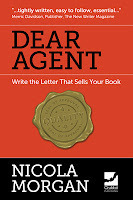 Exciting news for all fans of Nicola Morgan's helpful books on writing! This is one for all those who have actually written their book and are wondering about the next stage. (Previously ebook titles were Tweet Right and Write a Great Synopsis).
Exciting news for all fans of Nicola Morgan's helpful books on writing! This is one for all those who have actually written their book and are wondering about the next stage. (Previously ebook titles were Tweet Right and Write a Great Synopsis).For those of you new to this kind of practical and thorough advice, Nicola Morgan has been blogging at Help I Need a Publisher for some time. Her books are compilations and distillations of posts which she has created and had reader response to. (Go to her blog for extracts from Dear Agent and chances to win a free copy).
And I can assure you that even a hardened old pro like myself has found them full of excellent tips. I want to publicise Nicola's excellent special offer for those of you who have Kindles or the Kindle App on your computers:
Dear Agent will be available on Amazon on August 10th (and shortly afterwards elsewhere) for the STUPID price of 75p for THREE DAYS ONLY.
I don't want to jinx anything but I used my early copy to help me contact agents for my new venture of an adult book, under a pseudonym so no-one would know it was me. And I got a reply within 24 hours asking for the full manuscript!
 OK, that's not the same as a contract but I do put it down in no small part to Nicola's excellent advice. And as the author of more than 90 books, fiction and non-fiction in the last ten years, she really does know what she's talking about.
OK, that's not the same as a contract but I do put it down in no small part to Nicola's excellent advice. And as the author of more than 90 books, fiction and non-fiction in the last ten years, she really does know what she's talking about.
And I'm not even getting a percentage for this testimonial!
I'm just telling you that, if you have completed a book, this is the next one you need to get.
There isn't a link on Amazon yet but do take a look on Friday. You won't regret it.
Published on August 06, 2012 07:14
July 28, 2012
Margaret Mahy - the right to be murderous
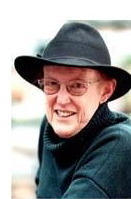 Photo courtesy HarperCollins
Photo courtesy HarperCollinsFive days after her death, there can be only one subject for this week's blogpost: the great and irreplaceable Margaret Mahy. I was away from home when I heard, having had no idea she was seriously ill, and it hit me hard, as it will every reader of this remarkably versatile and inventive writer's work.
I was lucky enough to have known her a bit, ever since I first interviewed her for School Librarian in 1986. We talked for hours on that occasion - about books (the ones we read and the ones we wrote), families (sisters in particular) and about finding the fabulous in the ordinary. She was already my role-model and hero because, as I did then and went on to do even more, she wrote picturebooks, junior fiction and stand-alone teenage novels.
I read the picturebooks to my daughters: The Man Whose Mother was a Pirate, The Lion in the Meadow and the immensely prescient Jam. When we moved to Oxfordshire, I too acquired a plum tree that was overly abundant and that bullied me into making many pots of jam - though, unlike the family in the story, we didn't quite use it for sticking back bathroom tiles.
Pirates were a recurring theme in Margaret's younger books. She told me she had adored a comic called The Adventures of Middy Malone, as a child, and was fascinated by the idea of women pirates and outlaws. 'I became very thrilled with the idea that women could have the power of life and death and the right to be murderous,' she told me.
But in the 80s, it was her distinctive teenage fiction that brought her new renown. The Haunting (1982) won her first Carnegie Medal, followed by The Changeover, which performed the same feat two years later and is to my mind, the better book. Indeed it is my favourite Mahy novel.
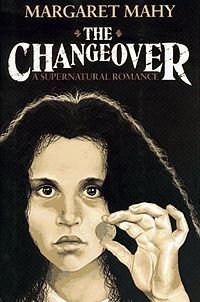
Laura Chant, aged fourteen, has to make the "changeover" into being a witch in order to save her brother Jacko from the marvellously-named demon, Carmody Braque, who is sucking the life out of the little boy. Laura makes this transformation with the help of an older boy at her school, Sorenson Carlisle. "Sorry" as he is known, is a witch from a line of witches, and as sexy as hell. But this is an adventure story, not a romance, and the characters' attraction to each other just a background for the sacrifice Laura must perform to rescue Jacko.
This book was followed by The Catalogue of the Universe (1985), The Tricksters and Aliens in the Family (both 1986), Memory (1987) - a remarkably rich run of fiction, which never dried up, even if the later novels never again quite reached the heights of her work in the 80s.
I met her several times in the 90s and she was always so generous to me, asking me to sign my books for her, as she did mine.
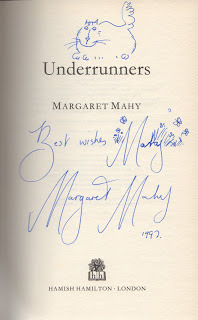
I'm sure I was not the only younger writer to feel her encouragement and warmth: "we're able to indulge in a bit of mutual admiration." When I started a campaign to support School Librarians (CENTRAL), Margaret kindly became its patron. She was a librarian herself and one can only envy the many children who experienced her whacky readings, as often as not dressed as a pirate in green or purple curly wig. She did a great deal to discourage the myth of the "lady librarian" as an uptight spinster and I dedicated my novel Special Powers to her, which featured two very attractive librarians my heroine had a crush on, one male, one female.
Margaret was a wonderful correspondent whether by email or letter in her spidery green handwriting, "which always looks to me a bit more sincere than print." She liked to be kept in touch with what she called "the wider world of books."
And she was the most amusing and stimulating companion, able to wow a room with her rendition of Monty Python's The Philosphers' Song, as she did at the Libraray Association the last time we met - the one that ends:
"Yes, Socrates, himself, is particularly missed;
A lovely little thinker but a bugger when he's pissed!"
You will be most particularly missed, Margaret. But if there is an afterlife, it will be a much more interesting and jolly place with you in it.
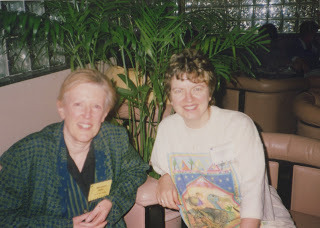 with Margaret Mahy at a conference in the US, I think 1993
with Margaret Mahy at a conference in the US, I think 1993
Published on July 28, 2012 13:03
July 19, 2012
The Gambler and the Cross-dresser - Western Archetypes by Caroline Lawrence
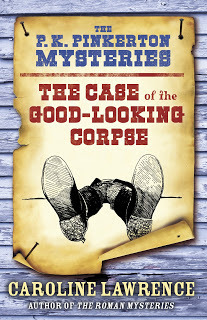 It's a great pleasure to welcome Caroline Lawrence back to the blog. I was writing about the impression her latest Western Mystery, The Case of the Good-looking Corpse, made on me just before I went off to Panama here. Caroline now tells us more about what she thought were her original creations and how she found something similar when she delved deeper into her current research.
It's a great pleasure to welcome Caroline Lawrence back to the blog. I was writing about the impression her latest Western Mystery, The Case of the Good-looking Corpse, made on me just before I went off to Panama here. Caroline now tells us more about what she thought were her original creations and how she found something similar when she delved deeper into her current research.I’m currently writing about the ‘Wild West’ in Nevada in the 1860s and trying to put a new spin on some of the stock characters of the Western genre.
Just as Greek Mythology boasts archetypes such as the Hero, his Companions, the Quest and a Monster, the American myth called ‘The Western’ has its own stock characters: the mysterious loner, the crusty sidekick, the hooker with a heart of gold, the respectable lady from back east, the gentleman gambler, the alcoholic doctor, the naïvely eager farm boy, the faithful steed and many others.
I decided to play around with some of these archetypes, to mix and match and ‘modernize’ them a little. I made my hero, P.K. Pinkerton, a mysterious loner (so far so typical) but then added some wild cards to the mix. I made him a kid, placed him on the autism scale and even put him in drag, all of which are unusual for a Western.
Instead of giving P.K. a crusty side-kick, I decided to give him a gentleman gambler whose USP is that he is a master at reading body language.
I plucked these 'starter-kit' archetypes from a subconscious fed by a thousand westerns. But then last month I came across some short stories by American author Bret Harte and I realised that he might well have been the original source of many of these western characters.
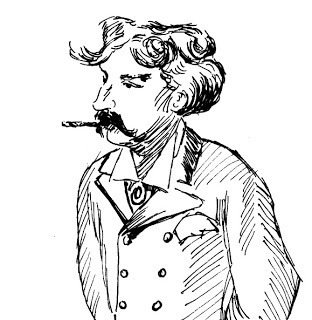 Bret Harte by Richard Russell Lawrence
Bret Harte by Richard Russell LawrenceWhy had Harte not figured on my radar before? Possibly because he is neither in vogue nor esteemed. Mark Twain despised him, although they had once been friends and collaborators. Twain once remarked that, ‘Bret wrote in a dialect which no man on heaven and earth had ever used until Harte invented it. It died with Bret Harte but it was no loss.’
Missouri academic Dr. Clark Closser adds, ‘Nothing about Harte’s death was a loss.’
Ouch!
I don’t care what Twain or the modern critics say. I think Harte is great. I love his subtly ironic deadpan humour and his vivid, ornate descriptions. He was also a writer who knew how to structure a story and end it with a twist.
Born Francis Bret Harte in 1836, a year after Twain, he grew up in Albany, New York and published his first poem aged 11. He read voraciously, studied Greek and Latin, but like many men of that period, his formal schooling ended when he was 13. He moved to California aged 17 and worked there as a miner, teacher, messenger, and journalist before he found a market writing about life in the California gold fields.
In The Luck of Roaring Camp, first published in 1868, Hart tells how a baby born to the camp prostitute transforms a passel of rough Californian miners. The next year Harte ‘struck pay dirt’ with The Outcasts of Poker Flat. In this tale the suave gambler Jack Oakhurst is asked to leave town after relieving its citizens of quantities of cash. The town drunk and a couple of prostitutes are exiled along with him. On their way to a more accommodating place they are joined by a young couple. However, the little group makes the mistake of camping in a mountain pass. When the town drunk absconds with their pack animals and snow begins to fall, disaster ensues.
The gentleman gambler Jack Oakhurst gets a brief mention in Luck and dies at the end of Outcasts, but he was obviously such a popular character that Harte felt obliged to resurrect him. Harte gives him some backstory in offerings like A Passage in the Life of Mr. John Oakhurst and creates his virtual clone in Jack Hamlin, from Brown of Calaveras.
Harte’s gentleman gambler is so much like one of my characters that I wondered if I subconsciously stole him. He wears black and rarely drinks. He is admired by men and desired by women. He is described as pale, dark-eyed, handsome, calm, contained, chivalrous, polite and – surprisingly – honest.
‘But isn’t he a gambler?’ queried the youngest Miss Smith. ‘He is,’ replied Hamilton; ‘but I wish, my dear young lady, that we all played as open and honest a game as our friend yonder, and were as willing as he is to abide by its fortunes.’ (A Passage in the Life of Mr. John Oakhurst)
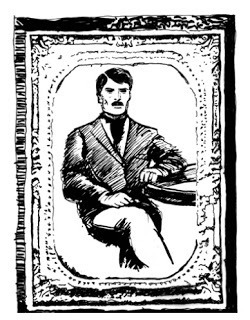 Jace by Richard Russell Lawrence
Jace by Richard Russell LawrenceMy gambler, Poker Face Jace, is also pale, dark-eyed, handsome, calm, contained, chivalrous, polite and honest. He dresses all in black and does not drink. I conceived Jace as a combination of Lee Van Cleef and ex-FBI body-language expert Joe Navarro, but he slips right into the mold.
Harte’s charming gentleman gambler never marries or has children, but we see his metaphoric children in Doc Holliday, the Sundance Kid, Maverick and many others.
Cool under pressure and mysterious, he might even be the grandfather of Clint Eastwood’s favourite characters: the Man with No Name from the Dollars Trilogy, the Stranger from High Plains Drifter and The Preacher from Pale Rider.
Another character I was thrilled to find in Bret Harte’s deck of cards was the cross-dresser, in this case a girl disguised as a boy. In The Poet of Sierra Flat there are two of them and they make a nicely contrasting pair. Milton Chubbuck is the eponymous poet, a strange, moist-eyed prospector who turns out to be a woman. The other cross-dresser is the California Pet, an androgynous music-hall star, whose ‘personation of boy characters’ and dancing of the ‘champion jig’ is hugely popular with the miners. In a cheekily risqué but understated ending, Milt and the California Pet end up going off together.
Whereas the charming gambler is a popular western archetype, there aren’t many cross-dressers in this genre. Ironically, as the recent book Re-dressing America’s Frontier Past has shown, there were probably more women-dressed-as-men than there were gentleman gamblers.
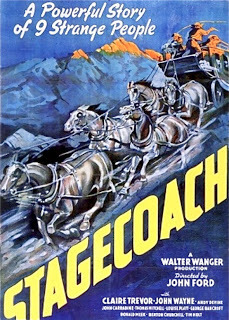
One clear example of Harte’s influence is the 1939 film Stagecoach by John Ford. Although the story on which the film was based has one or two parallels with a short story Butterball by Guy De Maupassant, it must also have been influenced by Bret Harte’s Outcasts of Poker Flat, which Ford had filmed twenty years before. The film begins with a handful of ‘outcasts’ forced out of town by the women’s temperance society. As the hooker with the heart of gold remarks, ‘There are some things worse than Apaches.’ Also leaving town is an elegant southern gambler called Hatfield, a whisky-loving doctor and an unjustly outlawed loner played by John Wayne in his breakout role after nearly 70 films. All of these archetypes can be found in Harte’s Western short stories.
What Harte has done should not be dismissed. He has created some marvellous characters that do what archetypes should do; they stand for an immediately recognizable class of person. It is then up to the storyteller to add nuances, quirks and eccentricities in order to bring them alive. Some academics have scathingly dismissed Harte’s characters as ‘stock’. But are they ‘stock’ if you are the first to create them?
As an American, Western Mythology is in my DNA. But I have only just realised that its Prometheus – the man who first gave shape to many of its best characters – was a writer named Bret Harte.
Published on July 19, 2012 17:01
July 15, 2012
City of Swords
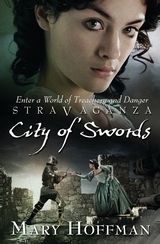 Last week the sixth volume of my fantasy sequence for Bloomsbury, Stravaganza, was published. It's the last, at least for now and since the sequence was originally planned as a trilogy, that's not bad going!
Last week the sixth volume of my fantasy sequence for Bloomsbury, Stravaganza, was published. It's the last, at least for now and since the sequence was originally planned as a trilogy, that's not bad going!In each book there is a twenty-first teenager from our world who time travels to a version of Italy in the sixteenth century. Talia is in a parallel dimension, where in the period when history and myth are hardly distinguished, Remus won the fight against Romulus and everything has been changed by "going down the other trouser-leg of time" as Terry Pratchett has it.
The City of Swords is Fortezza - loosely based on Lucca - and at the beginning of the Talian part of the story, its ruler, Prince Jacopo di Chimici, is dying. He is one the "good" de Chimici, that powerful family that tries to rule all Talia in the face of opposition from some independent city-states. For readers of the earlier books, Jacopo was a tower of strength after the wedding massacre in City of Flowers.
Laura is the new Stravagante from our world and she has a secret - one we don't learn till the end of the book. In this she is like the other Islington teenagers attending Barnsbury Comprehensive who have travelled to Talia. Each has been unhappy for a different reason and Laura's unhappiness has led her into being a self-harmer.
It was a subject I wanted to write about because it affects a terrifyingly large number of British teenagers. But within the context set up by these books it becomes just one of many plot strands. Laura travels to Fortezza, which is - ironically - the city of swords and finds herself in a swordsmith's shop. Her Talian Stravagante is Fabio, a swordsmith, and she soon finds herself caught up in a siege, surrounded by weapons that can do more damage than a razor blade.
Laura's talisman is a paper knife in the shape of a sword but unlike most paper knives it has a wickedly sharp blade. All the Stravaganti have talismans; they are what takes them from one world to another. But there is a story behind this one, which I have told before. These are the first five, some of them found after writing the books.

With City of Swords, I had a mental image of the paper knife and searched shops and stalls in Italy trying to find something that matched up to that image, with no success. And then in spring last year, when I had started writing the book, my sister came for Easter and casually said she's brought me something that had belonged to our mother because she had her own version, just the same. They came from Spain, but when I unwrapped it, there was my talisman!

Laura's is silver rather than this sort of dull gold but otherwise, it's exactly as I imagined it and it made me very happy to have it. I'm not superstitious but I do like to have an object about me that is linked to whatever book I am writing at the time and this gave a special impetus to Swords, which had to be handed in by the end of July - by28th in fact, as I left for a much-needed week's holiday the next day.
By then I had already passed a happy week in Lucca, refreshing my memories of the city and this time I walked the whole circuit of the complete medieval walls that encircle it. It took only an hour and a quarter - much less than my usual walks - and we also spent some time under the walls in the cavernous passages and tunnels that resurface as dungeons in the novel.
I shall miss being in Talia because it;'s a world I know so very well that I can just immerse myself in it every time there's a new book. The Italians have a good word for "goodbye." Arrivederci means "till we see each other again." That seems a good way to part.
Published on July 15, 2012 03:50
July 2, 2012
Ten legs and a man called Hyacinth

This ridiculously picture-postcard shot was one I took on Red Frog Beach on the island of Bastimentos in Panama (the Caribbean side). We are just back from two weeks with our youngest daughter and her partner on the boat they bought to sail round the world in.
It has been a bit of a shock to move from a tropical climate - very hot and humid - to a British July! We have been eating giant papayas and pineapples and picking coconuts up for free on the beach. The papayas in Waitrose looked stunted and shrivelled by comparison. And watching pelicans, frigate birds and eagles is much more fun than scooping up the dead sparrow one of the cats brought in within hours of their return from the cattery.
We worked out that our journey between daughter's boat and home had ten legs - ten different vehicles: dinghy, larger boat, shuttle bus to Panamian border, second shuttle to San José, taxi to airport, plane to Miami, plane to Heathrow, Piccadilly line tube, car to pick us up at Tube station and my car to drive home in.
The driver between San José and the border - both ways - was the delightfully-named Jacinto (pronounced Hassinto, because Latin American Spanish speakers don't lisp on the "c" like Catalans). He also had the nickname of El Pantera, the panther, but was a pussycat really.
That Panamanian border crossing was quite something. It took an hour in both directions to do the formalities, fill up forms, pay money, get stamped ... And then a walk over a VERY rickety wooden bridge. On the way back we were caught in the mother of all tropical rainstorms and were quite drenched by the time we climbed into Jacinto's minibus.
Very tired now (did I say 4 different time zones were involved?) but it was a lovely holiday. Swimming in the Caribbean sea was lovely, as was seeing our daughter after eight months. Next June, I wonder where she and we will be?
Meanwhile, here is a sunset in Bocas del Toro for you:

No literary news in this post; maybe I'll just become a picture postcard maker?
Published on July 02, 2012 13:30
June 15, 2012
I didn't mean to post again ...
before going on holiday. So dang you, Caroline Lawrence! I should be packing for Panama but instead am writing about pistol packing P.K.Pinkerton.
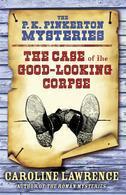
P.K. (Pinky), the gender-ambiguous child detective of The Case of the Deadly Desperadoes is back - and with a vengeance. Only the vengeance is directed towards Pinky by the two surviving desperadoes of the first book. And, to make matters worse, the one who was killed has left a power vacuum, which many other gunmen are just dying to fill (some literally).
But nothing will divert P.K. from the main business of discovering who murdered Short Sally, a "Soiled Dove" (see Glossary), albeit one who has retired from the Oldest Profession. (How does Caroline Lawrence get away with these things? Especially in the USA, I wonder).
The trouble is there are just too many men meeting the eye-witness's description and P.K. is not good at remembering faces. As before, the plot is a high-octane, roistering, cliffhanger-filled ride through the Wild West and P.K. the most interesting and unusual protagonist in Junior fiction.
Without doubt, Pinky runs The Number One Children's Detective Agency - though the drink of choice is Sarsaparilla rather than Redbush Tea!


P.K. (Pinky), the gender-ambiguous child detective of The Case of the Deadly Desperadoes is back - and with a vengeance. Only the vengeance is directed towards Pinky by the two surviving desperadoes of the first book. And, to make matters worse, the one who was killed has left a power vacuum, which many other gunmen are just dying to fill (some literally).
But nothing will divert P.K. from the main business of discovering who murdered Short Sally, a "Soiled Dove" (see Glossary), albeit one who has retired from the Oldest Profession. (How does Caroline Lawrence get away with these things? Especially in the USA, I wonder).
The trouble is there are just too many men meeting the eye-witness's description and P.K. is not good at remembering faces. As before, the plot is a high-octane, roistering, cliffhanger-filled ride through the Wild West and P.K. the most interesting and unusual protagonist in Junior fiction.
Without doubt, Pinky runs The Number One Children's Detective Agency - though the drink of choice is Sarsaparilla rather than Redbush Tea!
Published on June 15, 2012 06:03
June 11, 2012
Writers are not very nice people
I found myself writing a version of this sentence in the adult novel I have been revising. It is about a first-time writer, though not a novelist, and she realises the above when she starts viewing some of her new friends as copy.
It is nothing new - as old as storytelling itself, I suspect. Even when in the throes of grief or bliss, the writer has a little exterior brain with a bird's-eye view of every incident and character. But woe betide anyone else doing it to us!
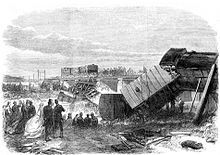
Charles Dickens was in the Staplehurst train crash in 1865. He tended the injured and dying, having been in the only carriage not to come off the rails. But he avoided giving evidence at the inquest, because he had been travelling with his mistress and her mother and did not want that fact to emerge.
Later he used the experience of the crash in a short story, The Signal Man. That 'mini-me' was on duty even when he had been giving sips of brandy to someone dying. I would be the same. It doesn't mean you can't be caring and kind; it just means you are aware of yourself being it.
Dickens ofter put versions of people he knew into his books. Mr Micawber was based on his father; Mrs Nickleby on his mother. But Elizabeth Dickens apparently did not recognise the portrait.
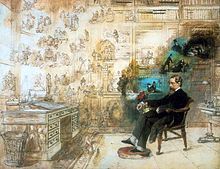 by Robert William Buss (1804–1875)
by Robert William Buss (1804–1875)
This famous painting, Dickens' Dream, executed five years after the writer's death, shows him in a reverie, surrounded by some of his most famous creations. For creations are what they are, not copies of real life people he knew, however much "inspired" by them they might have been.
It simply isn't possible to transfer real life events and people to the page, which is what I always answer to the inevitable question "do you put any of your family into your books?" Even if you started out with that intention, if the character is to come to life, it will grow and twist out of your grasp in unpredicted ways. And situations must be warped to fit the context of your story, even if it is the story of your own life.
There is another thing we do: we look at places to see if a visit to them can be made tax deductible by virtue of what we find there and can put into a book.
So watch this space for a story about sloths and red poison frogs, sea-turtles and margays. I'll be back in July.

It is nothing new - as old as storytelling itself, I suspect. Even when in the throes of grief or bliss, the writer has a little exterior brain with a bird's-eye view of every incident and character. But woe betide anyone else doing it to us!

Charles Dickens was in the Staplehurst train crash in 1865. He tended the injured and dying, having been in the only carriage not to come off the rails. But he avoided giving evidence at the inquest, because he had been travelling with his mistress and her mother and did not want that fact to emerge.
Later he used the experience of the crash in a short story, The Signal Man. That 'mini-me' was on duty even when he had been giving sips of brandy to someone dying. I would be the same. It doesn't mean you can't be caring and kind; it just means you are aware of yourself being it.
Dickens ofter put versions of people he knew into his books. Mr Micawber was based on his father; Mrs Nickleby on his mother. But Elizabeth Dickens apparently did not recognise the portrait.
 by Robert William Buss (1804–1875)
by Robert William Buss (1804–1875)This famous painting, Dickens' Dream, executed five years after the writer's death, shows him in a reverie, surrounded by some of his most famous creations. For creations are what they are, not copies of real life people he knew, however much "inspired" by them they might have been.
It simply isn't possible to transfer real life events and people to the page, which is what I always answer to the inevitable question "do you put any of your family into your books?" Even if you started out with that intention, if the character is to come to life, it will grow and twist out of your grasp in unpredicted ways. And situations must be warped to fit the context of your story, even if it is the story of your own life.
There is another thing we do: we look at places to see if a visit to them can be made tax deductible by virtue of what we find there and can put into a book.
So watch this space for a story about sloths and red poison frogs, sea-turtles and margays. I'll be back in July.
Published on June 11, 2012 05:56
May 25, 2012
Arvon Lady calling
 Isn't this a heavenly Secret Garden sort of image? I took it on my iPhone on Thursday morning, just before leaving Lumb Bank, near Hebden Bridge in Yorkshire.
Isn't this a heavenly Secret Garden sort of image? I took it on my iPhone on Thursday morning, just before leaving Lumb Bank, near Hebden Bridge in Yorkshire.I'd been up the night before to give the midweek talk on an Arvon Foundation course on Writing for Children. The tutors for the week were Julia Golding and Marcus Sedgwick, so the twelve participants had already had three days of first-rate advice and teaching from experienced and much published writers.
The Arvon Foundation has other centres, in Totleigh Barton in Devon, Moniack Mhor in Scotland, and the Hurst in Shropshire, all running courses on a similar pattern.
Lumb Bank used to belong to Poet Laureate Ted Hughes and in the 18th century was the home of a mill-owner. It still stands in 20 acres of woodland in countryside that falls and rises steeply. The house itself is sternly granite and made me think of Elizabeth's Gaskell's North and South.
But the tutors and midweek guest were housed in the "cottage" (itself a substantial three-bedroom building) on the hither side of this magical gate. Participants did their writing exercises on the vast dining table, which accommodated 15-16 people for dinner on Wednesday night with perfect ease.
Everything seemed on a gargantuan scale - fittingly for the home of the author of The Iron Man. My talk was on the upper floor of a separate barn, where I was facing a possibly eight-seater sofa!
I'd been asked to read from some of my books, answer questions and give an overview of my career. I had an hour to an hour and a half, about half of it set aside for questions. And I have written 96 books so it was a hard task to condense that down.
As I read a passage from Stravaganza: City of Masks in which the magician Rodolfo (he would describe himself as a scientist) sits hunched in a chair 'like a hawk roosting" I thought I felt the spirit of Ted Hughes just lightly pass.
Have you ever been on a creative writing course? And if so, how did you find it?
 Idyllic scene from tutors' cottage, Lumb Bank
Idyllic scene from tutors' cottage, Lumb Bank
Published on May 25, 2012 09:49
Mary Hoffman's Blog
- Mary Hoffman's profile
- 591 followers
Mary Hoffman isn't a Goodreads Author
(yet),
but they
do have a blog,
so here are some recent posts imported from
their feed.



